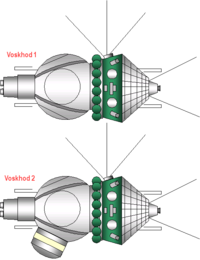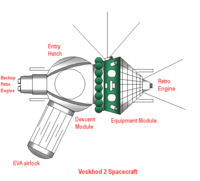Voskhod programme

The Voskhod programme (Russian: Восход, "ascent", "dawn") was a Soviet human spaceflight project. Voskhod development was both a follow-on to the Vostok programme, recycling components left over from that programme's cancellation following its first six flights. The two missions flown used the Voskhod spacecraft and rocket.
Contents |
Design

The Voskhod flights were, in retrospect, merely aimed at making Soviet "firsts" in space exploration. While these missions were the goal of the Politburo's influence on the efforts of the Soviet space programme, they were achieved by significantly decreasing safety and reliability.
The Voskhod spacecraft was basically a Vostok spacecraft that had a backup, solid fuel retrorocket added to the top of the descent module. The heavier weight of the craft was made possible by improvements to the R-7 Semyorka-derived booster. The ejection seat was removed and two or three crew couches were added to the interior at a 90-degree angle to that of the Vostok crew position. However, the position of the in-flight controls was not changed, so the crew had to crane their heads 90 degrees to see the instruments.
In the case of Voskhod 2, an inflatable exterior airlock was also added to the descent module opposite the entry hatch. The airlock was jettisoned after use. This apparatus was needed because the vehicle avionics and environmental systems were air-cooled, and depressurization in orbit would cause overheating. There was no provision for crew escape in the event of a launch or landing emergency. A solid fuel braking rocket was also added to the parachute lines to provide for a softer landing at touchdown. This was necessary because, unlike the Vostok, the Voskhod descent module landed with the crew still inside.
Comparison with Gemini
After the first-generation spacecraft Vostok and Mercury had proved the technical feasibility of manned spaceflight, NASA proceeded to build their second-generation capsules, Gemini, which were a completely new design which retained the successful features of Mercury, like escape rockets or a conical shape with a heat shield at the bottom.
But several new features were added to Gemini, for example engines strong enough to significantly alter the orbit, docking and rendezvous facilities, and provisions for EVA, all of which were essential for practical applications of spaceflight, namely a manned moon mission.
In comparison to that, Voskhod capsules were simply modified Vostok craft, reatining most of Vostok's limitations. After all, Voskhod turned out to be a dead end and was abandoned after only two manned missions, to be superseded by the much more capable Soyuz.
Flights
The Voskhod flights, with their dates of launch, were:
Unmanned
- Cosmos 47 - Unmanned test flight of the Voskhod hardware.
- Cosmos 57 - Unmanned test flight, unsuccessful.
- Cosmos 110 - Unmanned, sent two dogs, Veterok and Ugolyok, on 22-day flight, launched 22 February 1966.
Manned
| Order | Mission | Launch | Duration | Landing | Crew | Notes | ||
|---|---|---|---|---|---|---|---|---|
| 1 | Voskhod 1 | 12 October 1964 | 1 d 0 h 17 m 3 s | 13 October 1964 | V. Komarov | K. Feoktistov | B. Yegorov | First multi-person spacecraft. |
| 2 | Voskhod 2 | 18 March 1965 | 1 d 2 h 2 m 17 s | 19 March 1965 | P. Belyayev | A. Leonov | First spacewalk. | |
Cancelled
- Voskhod 3 - 19-day mission to study long-term weightlessness
- Voskhod 4 - 20-day mission to study long-term weightlessness
- Voskhod 5 - 10-day all-female crew, first female EVA
- Voskhod 6 - Flight to test new EVA jet belt
Results
While the Vostok programme was dedicated more towards understanding the effects of space travel and microgravity on the human body, Voskhod's two flights were more aimed towards spectacular "firsts". Although achieving the first EVA ("spacewalk") became the main success of the programme, beating the U.S. Gemini programme to put the first multi-person crew in orbit was the objective that initially motivated the programme. Once both goals were realised, the programme was abandoned. This followed the change in Soviet leadership, which was less concerned about stunt and prestige flights, and allowed the Soviet designers to concentrate on the Soyuz programme.
External links
|
|||||||||||||
|
|||||||||||
